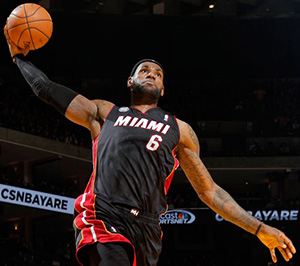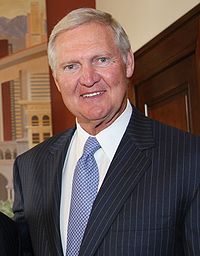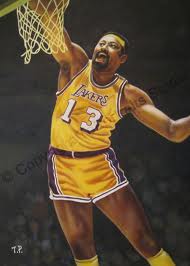
 Even though the Bulls unexpectedly upended Miami on Wednesday, the Heat still possess the second-longest winning streak in NBA history. The 33 consecutive games won by the 1971-72 Los Angeles Lakers still stands atop the record book. Even so, and given the difference in the game from then to now, comparing these two remarkable teams is an irresistible exercise in fantasy. So here goes.
Even though the Bulls unexpectedly upended Miami on Wednesday, the Heat still possess the second-longest winning streak in NBA history. The 33 consecutive games won by the 1971-72 Los Angeles Lakers still stands atop the record book. Even so, and given the difference in the game from then to now, comparing these two remarkable teams is an irresistible exercise in fantasy. So here goes.
OFFENSE: STARTING FIVES
 LeBron James is clearly the best wingman of the lot, an unparalleled combination of talent, size, speed, and power. He is also virtually unstoppable when he attacks the rim, and has become a dangerous, if streaky, perimeter shooter. LBJ’s court vision and ability to deliver timely passes are likewise exceptional.
LeBron James is clearly the best wingman of the lot, an unparalleled combination of talent, size, speed, and power. He is also virtually unstoppable when he attacks the rim, and has become a dangerous, if streaky, perimeter shooter. LBJ’s court vision and ability to deliver timely passes are likewise exceptional.
Dwayne Wade is an erratic shooter but a powerful and creative lane penetrator.
Chris Bosh slithers into the open spaces created by opponents having to aim their defenses at LeBron and Wade. His mid-range (and sometimes even longer) jumpers are reliable, plus he can score in the low-post against slower defenders.
Udonis Haslem plays ferocious defense, cleans the glass, and can knock down uncontested mid-range jumpers.
Mario Chalmers is essentially a scorer (and an effective one) who concentrates on getting the ball to Miami’s Big Two Plus One.
For the Lakers, Jerry West was in incredible stop-and-pop shooter going right. His release was so quick as to make his shots unguardable. When he rarely penetrated, West was an accurate (and underrated) passer.
 LeBron was shaky in the clutch until last season, and his free-throw shooting in endgames remains somewhat erratic. As I’ve discussed before, the renown Mr. Clutch wasn’t quite as good in critical situations as the fawning media have made him out to be—but he was still a tad better than LBJ.
LeBron was shaky in the clutch until last season, and his free-throw shooting in endgames remains somewhat erratic. As I’ve discussed before, the renown Mr. Clutch wasn’t quite as good in critical situations as the fawning media have made him out to be—but he was still a tad better than LBJ.
Gail Goodrich was LA’s leading scorer and, like West, a deadly jump shooter. If “Stumpy” didn’t appear to be overly athletic, he always seemed able to find and move into open lanes. Passing wasn’t Goodrich’s job description.
Jim McMillian’s jumper was money from either baseline. Like Ray Allen, he was a master at perpetually moving to make optimal use of picks.
Happy Hairston was a board-banger, dive-cutter, pick-setter, and runner, who didn’t need the ball to score his 13.1 points per game.
At age 35, Wilt Chamberlain still had plenty of game. He deferred his previous Gargantuan point-making heroics to West and Goodrich, but in emergencies or extremely favorable matchups, Wilt could still finger-roll, dunk and put-back his way to occasional 30-plus-point dominations. Having already led the NBA in assists (1967-68), Wilt was a proven, willing, and accurate passer. Just as important, the monstrous Wilt was also a double-pick unto himself.
Of course, the 3-point field goal was not in existence in 1971-72, but otherwise the Lakers could more than match the Heat shot-for-shot.
Give Miami the edge for the ability of LeBron, Wade, and even Chalmers to drive the ball into the lane. But the difference is Chamberlain—there’s no way Bosh, Haslem, Joel Anthony, or Chris Andersen could keep him from dominating the paint, or prevent him from scoring 20 points on put-backs alone. Doubling the Big Dipper (something that was illegal back then) would be suicidal because of the Lakers’ unselfish passwork and the dead-eye shooting of West, Goodrich, and McMillian.
The advantage here goes to LA for its versatile inside-outside capabilities.
BENCH OFFENSE
Shane Battier, Ray Allen, Mike Miller, and Norris Cole get most of their shots on kick-out or reversal passes that result when defenses merge on the rim-assaults of LeBron and/or Wade. For LA, Flynn Robinson was a dynamic and creative scorer when operating on his own recognizance.
LOOKING FOR HEAT TICKETS? LOOK NO FURTHER
LOOKING FOR LAKERS TICKETS? WE’VE GOT THOSE, TOO
LeRoy Ellis was a 6’11” shooter who could lure opposing big men into playing defense way beyond their comfort zones. Pat Riley was a scrapper who couldn’t shoot himself in the foot. Ditto for Keith Erickson.
Slight edge to Miami.
TEAM DEFENSE
 Goodrich was a liability on defense, and Hairston was satisfactory. But McMillian, West, Riley, and Erickson were stoppers. Then there was Wilt to protect the basket.
Goodrich was a liability on defense, and Hairston was satisfactory. But McMillian, West, Riley, and Erickson were stoppers. Then there was Wilt to protect the basket.
Years ago, I wrote a book about the 1971-72 Lakers (THAT PIVOTAL SEASON) in which I collected and studied the box scores and newspaper reports of every game LA played. If blocked shots were not officially recorded until 1973-74, courtside sportswriters routinely credited Chamberlain with ten blocks in those games where they were motivated to keep track of this unofficial number. In a few games, these professional eyewitnesses counted fifteen (and sometimes more) blocks.
So, then, picture LA’s defenders playing up-tight on LBJ and Wade, thereby forcing them to drive into the dead-end of Chamberlain’s layup-preventing presence. Also, Wilt was much quicker than most veteran fans might remember him as being—plus he could wait until a shot was released before jumping to deflect it. The point being that he could hold his ground and be in position to contest any interior shot that resulted from a drop-off pass by the lane-penetrator.
And if rebounding is the last aspect of defense, Chamberlain (a league-leading 19.2 rebounds per game) and Hairston (13.1) would nullify most of the extra shots and easy scores (what little of them exist) generated by Miami’s offensive rebounding.
A significant advantage here for the Lakers.
Well well well.
The 2013-2014 NBA Champions are the San Antonio Spurs. They destroyed Lebron and Miami in 5 games.
The key was that they played superbly on offense – everyone a willing passer to the open many. And on defense, the Big Fundamental Tim Duncan lead the team in strongly defending Miami. The Spurs beat Miami with the largest margin of victory ever in an NBA finals. The Spurs were the fundamentally sound team. As such they exposed all of Miami’s weaknesses – including the lack of a bench and center.
This tells me that the 1971-72 Lakers would SLAUGHTER the Miami Heat in 4 games given the presence of the Big Dipper Wilt Chamberlain and the sound fundamental game each of the Lakers had since they all completed college.
Only issue is I have is why there is such a gap between articles. I hope this improves for the playoffs
Good, solid article. After all, Rosen wrote the Pivotal Season, which covered the monumental season of the 1971-1972 Lakers.
The only other person who I imagine to have a credible opinion would be Pat Riley. He was a scrappy bench player on the 72 Lakers, and is now the dictator of the 2013 Heat.
He probably has better insights about the Heat, no question, due to his proximity.
However, Riley is still part of the Miami Heat organization, and that position requires him to be more political than objective.
Good article! This is why I love Charley’s writing.
Also, when I read the headline the first thing I thought of was Wilt looking down at Chris Bosh and saying, “And what position do you play, little man?” in that basso profundo voice. And boy, did I laugh at that.
Agreed. Wilt Chamberlain, a guy that made Arnold Schwarzenegger look weak, against the RuPaul of big men. Hilarious thought.
Lebron James recently complained about the physical play Chicago gave him when Chicago beat James and Miami a few days ago.
Physical play was more severe in the 1970s. Lebron would have to expect getting physically assaulted every game. There was no room for cry babies back then. Lebron also wouldn’t be able to move as freely since he would be hand-checked every minute he was on the court.
Miami is still vulnerable to teams with legitimate centers and rebounders since they have a huge hole in the middle. And they are vulnerable to teams that will aggressively and physically play them.
The Lakers have Wilt who blocked 10+ shots per game and averaged 19+ rebounds that year at center. With the physical play of those days, Lebron and Wade’s game would be limited to perimeter jump shots.
Yes, by 1970s rules, the Lakers would dominate Miami.